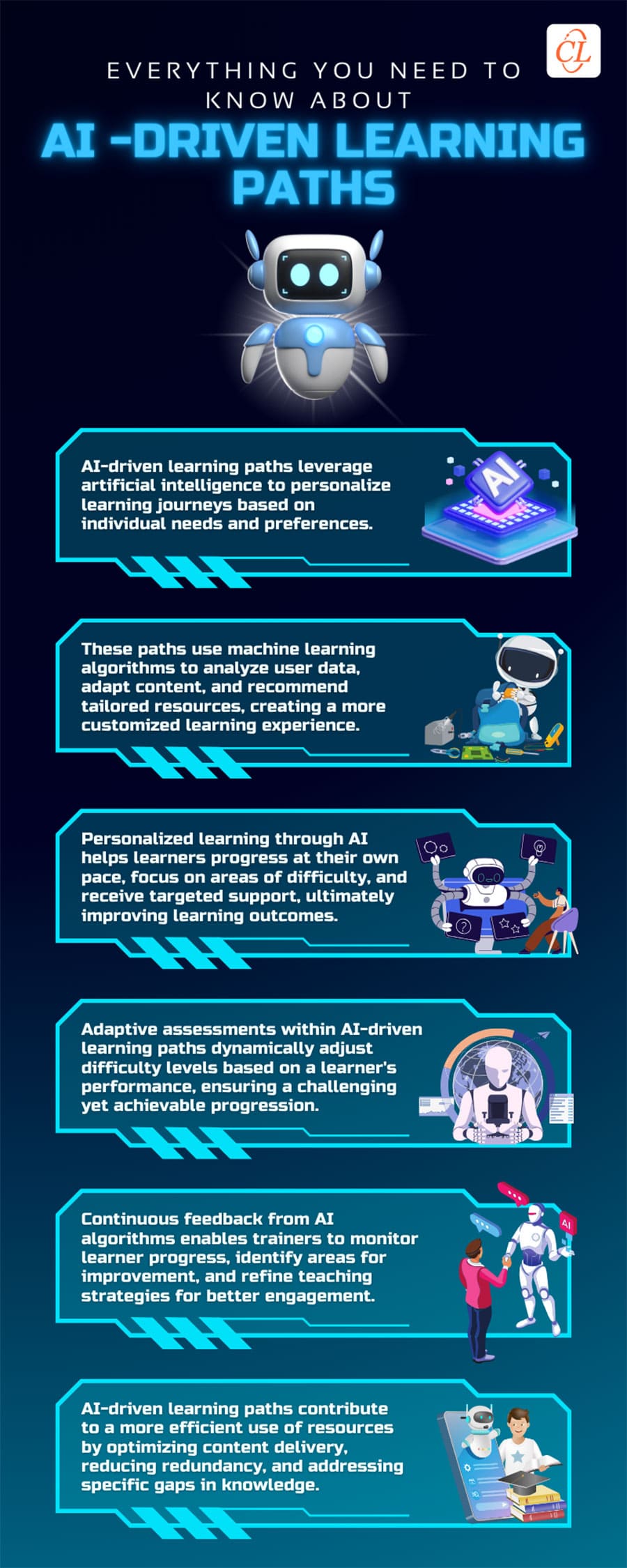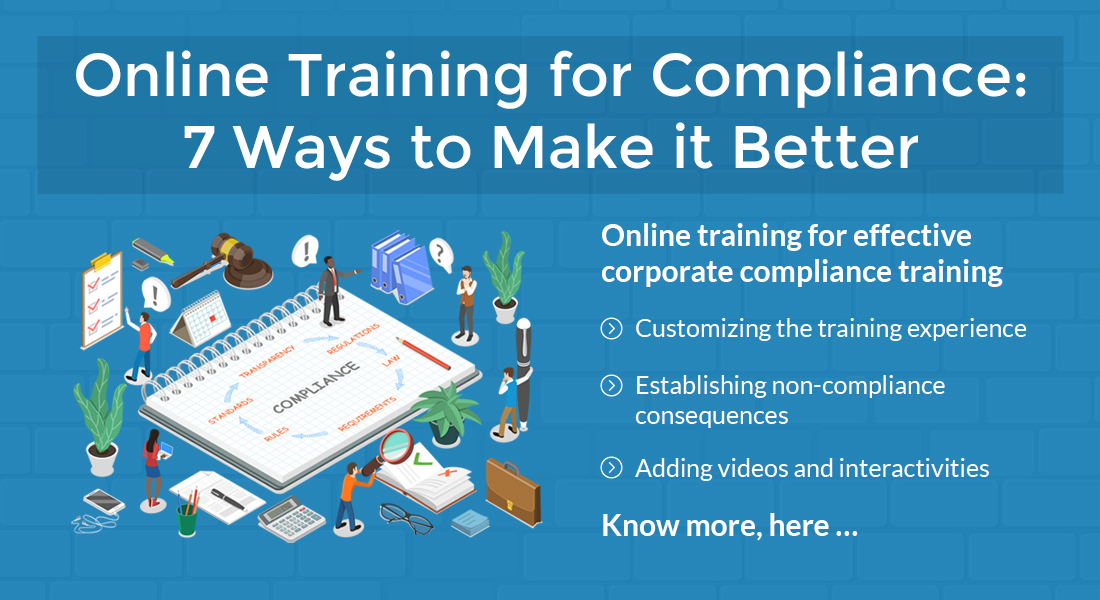Corporate Training Predictions You Can’t Afford to Miss — 2025 Edition

Ever wondered what the future of corporate training looks like? It’s not just about boring PowerPoints and endless webinars anymore. The game is changing, and fast! From virtual reality simulations to AI-driven personalized learning, the possibilities are as exciting as they are transformative.
The workforce is evolving, and so are the ways L&D teams train and upskill employees. Imagine immersive training environments that feel like real-life scenarios or customized learning paths tailored to each individual’s needs. The future of corporate training is here, and it's anything but ordinary!
Let’s dive into what’s next.
→ Download Playbook: 2025 Goal Tracker for L&D Managers [Make Winning a Habit!]
Table of Content
- Repositioning Training as an Investment, not an Expense
- Alignment of L&D with Business Goals
- Adaptive Content Delivery
- Personalized Learning
- Rising Importance of Marketing Your L&D Initiatives
- A Sharp Focus on Soft Skills
What are the Top 2025 Corporate Training Predictions?
Do You Know Where the Future of Corporate Training is Heading Towards?
Here are a Few Ground-breaking Predictions:
- Alignment of L&D with Business Goals
- Data-driven Training
- AI Evolution
- And More!
1. Repositioning Training as an Investment, not an Expense
You’ve probably heard managers and leaders talking about the costs of onboarding and training employees. For years, corporate training has been considered an expense, especially for organizations with lacklustre, outdated, or ineffective programs. In contrast, modern organizations are now seeing it as an investment.
This shift in mindset is mainly due to the rapid digital transformation initiatives that saw business digitalize their operations and employ new technologies. Those who were able to upskill or reskill their workforce to adopt these changes have not only ensured continuity but are also reporting growth in performance.
From an employee’s point of view, training has always been considered a necessary burden. However, now, they’re seeing it as any other tangible or intangible benefit offered by their companies. Many modern employees opt for organizations with extensive training programs that could help them improve their capabilities and elevate their careers.
Additionally, this shift is redefining the role of L&D professionals. As companies prioritize training, L&D leaders are no longer just facilitators—they are increasingly seen as strategic impact makers. Their role is evolving to shape workforce skills, drive organizational growth, and directly contribute to building a sustainable future for the business.
Have a look at this infographic to understand how L&D professionals are turning into impact-makers.

2. Alignment of L&D with Business Goals
In recent times, the role of L&D has gained immense prominence, and it has become an indispensable part of businesses. L&D teams have strategic roles to play in crafting training strategies that aim at persistent learning and growth of employees while harmonizing with the business goals.
Wondering how to go about aligning L&D with business goals?
Let’s make it simple. Make a note of your business objectives for the coming year, understand your learners’ learning needs and preferences, and then craft learning strategies that lead to the desired learning outcomes to achieve the set business goals. Embrace new-age learning trends to cater to the modern digital workforce for impactful learning.
3. The AI Revolution
4 in 5 people want to learn more about how to use AI in their profession.
It is unarguably true! Today’s world is driven by technology. Artificial Intelligence or AI is everywhere. Right from Alexa to the best beauty product suggestion at beauty store, or the chatbots on business websites. When it comes to corporate L&D, things are no different. AI can give a new twist to your corporate training tale. Investing in AI tools and technologies that offer a magical makeover to your learning framework and help you ace the training initiatives in the year ahead. By using AI, not only you can design interactive courses, but also get deeper insights into analytics to craft personalized learning journeys for your learners.
4. Data-driven Training
No business initiatives in the digital age survive without data to support them. Therefore, you cannot expect companies to invest in training programs without valuable insights. Thus, we can expect a massive increase in the adoption of data-driven and AI-powered technologies for L&D. Organizations can use these solutions to receive regular reports on compliance, skills gaps, employee performance, training progress, and industry practices.
AI plays a vital role in taking this a step further by analyzing large amounts of data to provide personalized learning paths, recommend specific training modules, and predict future skills requirements. AI-driven tools can adapt training programs to individual employee needs, ensuring more effective and efficient learning outcomes.
Another important reason for leveraging data-driven and AI-powered L&D technologies is to enhance leadership training. Organizational change starts from the top, and upskilled or reskilled leaders—supported by AI insights—can create better ways to engage with their teams and improve their performances.
5. Adaptive Content Delivery
One of the most exciting advancements in the training world is adaptive content delivery, a technology powered by AI and machine learning. This innovation has the potential to revolutionize corporate training by tailoring content to individual learners' needs, preferences, and progress. Imagine an eLearning platform similar to Netflix, but instead of recommending shows, it predicts learner behavior to deliver personalized learning experiences. By analyzing past performance, engagement patterns, and skill gaps, the software can dynamically adjust the curriculum to maintain interest, challenge users appropriately, and ensure long-term knowledge retention. This not only makes training more engaging and effective but also helps organizations maximize the potential of their workforce by providing the right learning at the right time.
Related Read: Adaptive Learning Tools: Understanding How They Sequence Content
6. Extended Reality (XR)
Extended Reality (XR) is set to transform corporate training in 2025. Combining Virtual Reality (VR) and Augmented Reality (AR), XR will become a cornerstone of employee development programs. VR will enable employees to master complex skills, like operating machinery or navigating high-pressure scenarios, in a safe and realistic setting. At the same time, AR will elevate hands-on learning by overlaying real-time guidance and instructions onto physical tasks, from equipment assembly to troubleshooting. XR will redefine workplace training, making it more immersive, efficient, and impactful.
Watch this video to explore how Extended Reality, VR, and AR, are revolutionizing corporate training and shaping the future of workforce development.
7. Virtual Mentorship Programs
As remote work continues to dominate in 2025, companies are increasingly hiring new employees, including many recent graduates with limited real-world experience. While these graduates often possess strong technical and theoretical knowledge, they struggle to apply it to practical situations.
To bridge this gap, virtual mentorship programs have become a key aspect of employee training and development initiatives. Companies are leveraging in-house managers or hiring external mentors to coach and guide less experienced employees. These programs not only help new hires translate their skills into real-world applications but also enhance their productivity, engagement, and long-term career growth in an increasingly remote-first workforce.

The 2025 L&D Managers’ Playbook
Make Winning a Habit!
- Take stock of your current state
- Set goals for your personal growth
- Define your professional upskilling targets
- Use the tracker, wheel of life, and other tools
- Stay on the path of success
8. Growth in Informal Learning
The continued evolution of the web and advancements in AI-driven tools are driving the rapid rise of informal learning in 2025. The "guerilla learning" approach, popularized by millennials, has expanded with Gen Z and younger professionals embracing this trend. Today's workforce prefers on-demand, issue-based learning over structured programs.
For example, when facing a challenge with a software tool, employees now rely on AI-powered assistants, interactive forums, digital manuals, and real-time collaborative platforms instead of traditional training. The massive growth of online resources—like AI-generated podcasts, immersive videos, virtual workshops, blogs, and webinars—has transformed informal learning into a dynamic, personalized experience for professionals across industries.
Want to use informal learning at the workplace for optimal training? Have a look at this infographic!
9. Big Data
The need to provide quantitative data to prove the effectiveness of an eLearning program is inevitable. Learning Management Systems (LMS) store the data of employees’ learning results, courses completed and attended, internal ratings, appraisal scores, and more.
The data generated can be used to improve learning effectiveness. Now organizations can exploit big data from various sources other than an LMS, such as Customer Relationship Management (CRM), Human Resource Management (HRM), Human Resource Information System (HRIS), Enterprise Resource Planning (ERP) and other software applications.
These tools help training departments prove and quantify the relevance of the applied learning strategies with accurate data. Not only that, big data enables eLearning providers to customize learning content and facilitate relevant training and assess the effectiveness of those employee training and development programs.
Related Read: Learning Analytics: Getting Smart with Big Data
10. Wearable Technology
Devices like Apple Watches, smart glasses, and advanced VR headsets will redefine corporate training. Wearable technology has made 3D simulations more immersive than ever, bringing virtual training to industries across the board. Virtual Reality (VR) in eLearning enables developers to create highly engaging, realistic training modules that resonate with today’s workforce.
Thanks to technological advancements, the cost of VR headsets and other wearable devices has become more affordable, making them accessible to businesses of all sizes. With VR, high-risk tasks can now be taught through 3D simulations, allowing employees to practice safely in a virtual environment.
11. Personalized Learning
The adoption of personalized learning approaches is growing at a rapid speed. Traditional one-size-fits-all training programs are being replaced by tailored learning experiences that cater to the unique needs, preferences, and learning styles of individual employees. With the help of advanced technologies like AI and machine learning, training modules can be customized to provide targeted content, adaptive assessments, and personalized feedback. This personalized learning approach not only enhances employee engagement and motivation but also ensures that learning is more efficient and effective. By empowering employees to take control of their own learning journeys, personalized learning is driving continuous skill development and fostering a culture of lifelong learning within organizations.
Check out this infographic showcasing the key features of AI-driven learning paths. Dive in to explore and learn more!
12. Collaborative Learning
Collaborative learning will take a major leap forward, driven by advanced technologies that prioritize seamless teamwork and knowledge sharing. Virtual Reality (VR) and Augmented Reality (AR) tools will create immersive environments for employees to work together, regardless of their physical location. AI-powered platforms will personalize learning experiences, ensuring that each team member can contribute effectively while addressing individual skill gaps. Global corporate training programs will benefit from real-time language translation tools, allowing diverse teams to collaborate without language barriers. These innovations will not only enhance productivity but also foster stronger connections and a shared sense of purpose among distributed teams, transforming the way organizations approach professional growth and development.
Related Read: Everything You Need to Know about Collaborative Learning
13. Learning Culture
Heard this famous quote? “Life is a classroom. Only those willing to be lifelong learners will move to the head of the class”- Zig Zagler.
When you design your L&D programs that promote learning and growth, you build a workforce that’s always moving ahead with ever-evolving industry trends. Consistent upskilling and reskilling opportunities make employees feel that you are genuinely interested in investing in their growth which subsequently boosts their morale to go that extra mile and deliver for customer delight. Make learning a part of the workflow rather than restricting your learners to stringent training schedules. Encourage collaboration through peer-to-peer and social learning to involve learners and make learning an enjoyable journey.

Building a strong learning culture is essential for any organization's growth, but it’s not without its challenges. In this video, we’ll explore the common obstacles and how to overcome them to create a thriving learning environment.
14. Rising Importance of Marketing Your L&D Initiatives
Just like making a good product is not all, you need to market it to get it sold, designing awesome courses and parking them in your Learning Management System (LMS) is only half the job done. You need to market them in-house to garner the attention of your learners. Plan catchy teaser videos for your upcoming courses and put them up on common channels before the course launches. You can also mention them at the end of your popular courses and podcasts to grab attention and enhance course enrolments. Don’t forget to acknowledge and reward learners for sparing time to upskill and reskill themselves amidst busy calendars.

The 2025 L&D Managers’ Playbook
Make Winning a Habit!
- Take stock of your current state
- Set goals for your personal growth
- Define your professional upskilling targets
- Use the tracker, wheel of life, and other tools
- Stay on the path of success
15. Agile Learning
The brick-and-mortar setup is a story of yesteryears. It’s time to revamp your training strategy to match the latest trends in the corporate L&D landscape. Agility is the key. Craft your learning strategy to make training a part of the workflow. Design courses that deliver moment-of-need learning.
Short microlearning modules in the form of videos, podcasts, interactive PDFs, or digital flashcards are great for delivering short bursts of knowledge to your learners. You can also opt for the blended learning approach to match your learners’ needs in today’s dynamic business scenario. Under the blended learning umbrella, you can plan to deliver content in the form of eLearning courses, short microlearning nuggets, or virtual training sessions and make learning enjoyable. Ensure to invest in an LMS to host and manage your online learning courses for anywhere anytime access of your learners.

16. Digital Technologies Will Transform Instructor-Led Training
In 2025, digital technologies are expected to revolutionize instructor-led training, making it more dynamic and efficient than ever before. Trainers will be able to leverage digital tools to quickly update and distribute content, ensuring sessions remain relevant to constantly evolving business needs. This adaptability not only keeps the training aligned with industry trends but also reduces costs, minimizing reliance on printed materials and eliminating the need for extensive travel for trainers and attendees.
For learners, the integration of digital tools brings exciting benefits. Interactive features create more engaging and personalized learning experiences. Participants can revisit materials at their own pace, ensuring they fully grasp complex concepts. As businesses embrace digital learning in instructor-led settings, they’ll create more dynamic, efficient, and impactful classrooms.
17. A Sharp Focus on Soft Skills
Corporate training is significantly shifting toward developing soft skills, acknowledging their vital role in creating a more dynamic and effective workforce.
As automation and AI increasingly take over routine and technical tasks, the emphasis will move toward the human element—qualities that cannot be replicated by machines. Employees will need strong interpersonal skills to build meaningful relationships, navigate complex workplace dynamics, and adapt to constant technological and organizational changes. Moreover, leaders will rely on these soft skills to inspire, motivate, and guide their teams through uncertainty while driving productivity and maintaining a competitive edge in the market.
This evolution in corporate training reflects a broader understanding that technical expertise alone is no longer sufficient. By offering employees effective soft skills training, organizations aim to create a workforce that is agile, connected, and prepared to face the challenges of the future.
Key soft skills in demand will include:
- Effective communication
- Emotional intelligence
- Problem-solving and critical thinking
- Adaptability and resilience
- Collaboration and teamwork
- Leadership and conflict resolution
The Path Ahead
The future of corporate training is brimming with opportunities to redefine how employees learn and grow. With innovations like AI-driven learning platforms, immersive VR experiences, and hyper-personalized training modules, organizations have the chance to create impactful, engaging, and results-driven learning environments like never before. The key is for companies to embrace these changes with open arms, staying ahead of the curve to equip their teams for the challenges of tomorrow.
As the workplace continues to evolve, corporate training will no longer just be a box to check—it will become a strategic advantage. Forward-thinking companies that invest in cutting-edge training solutions will not only nurture top talent but also build a culture of continuous learning and adaptability. The future of corporate training isn't just coming—it's already here. Are you ready to lead the way?
Download the 2025 L&D Managers’ Playbook! This comprehensive tracker is custom-made for L&D leaders like you, offering a structured way to set, track, and achieve your goals. It allows you to assess your current priorities, identify areas for improvement and plan for a successful year ahead. Plus, it's packed with useful resources to assist in your upskilling journey.
So, what are you waiting for? Download the playbook, commit, track, and create an empowering 2025 for yourself. Grab your copy today!







